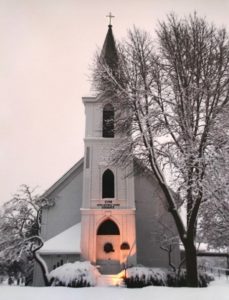A Zion Perspective on History
Remember Our Shared Past

The Evangelical Church could boast that it was 100% American. It was established in 1800 on American soil by American citizens who were not persecuted in the Old World, not exiled by governments there. It never was a victim of Old World superstitions and religious heresies, and came into existence in a new and young, democratic country and government, a pioneer of the New World.
Founded by Jacob Albright who was sometimes described as a “flaming evangelist”, he preached in Pennsylvania, converting many and calling some to preach with him, organizing new congregations first, then a Conference, and finally the denomination. Early ministers soon pioneered westward along with immigrants, as mentioned in last month’s newsletter account. The heart of the new Evangelical denomination was so big that Old World immigrants found a welcome in this new church in their new lands as they extended settlement into Ohio, Indiana, Illinois, and the Wisconsin Territory, namely the Milwaukee mission. By 1840 the first class in Wisconsin of Evangelicals was organized at Greenfield. A few years later the missionary stationed in Wisconsin, Rev. M. Hauert, extended his work to the northwest and his successor, Rev. A. Nicolai, served the newly formed congregations within the Menomonee Falls circuit. These community “classes” (as the early congregations were known) first met in members’ homes until enough resources (land, manpower, capital) were secured to build houses of worship. The Motz class, meeting in Colgate, built its first structure made of logs in 1851 on land donated by a retired pastor who had moved out from Greenfield. This log church was eventually replaced in 1886 by the current frame structure standing, adjacent to the Zion Colgate Cemetery, on the same donated parcel of land.
The other classes that comprised the Menomonee Falls circuit (and organized at various times) were in Germantown and Richfield. These all were served by many pastors whose circuit station rarely lasted longer than three years. At times, they did have assistants, some more successful than others. During the first decade of the 1900s, a congregation was nearly formed in neighboring Sussex. But during an absence by the pastor, enthusiasm waned and a congregation was never formed. [Note that the existing Sussex United Methodist Church came from the Methodist strain of history, not the Evangelical strain.] In 1930, the Menomonee Falls circuit divided when the Colgate-Richfield congregations became a separate charge housing their own subsequent pastors in a newly built parsonage in Richfield.
REJOICE in Our Unity of Faith
1946 brought change to the Evangelical Church when it joined with the United Brethern denomination to form the Evangelical United Brethern (EUB) Church. That same year marked the centennial celebrations of both the Menomonee Falls and Colgate (Evangelical) congregations.
In 1967 a new parsonage in Colgate was built at a cost of $29,310. The Colgate and Richfield congregations then could each become separate charges and support their own pastors who were appointed following the retirement of Rev. Clifford E. Olsen, a beloved pastor who served the two congregations for the previous 17 years! His daughter, Lois Olsen, had become an EUB missionary who was sponsored by the Colgate congregation. She practiced nursing and midwifery in Sierra Leone and Kenya, Africa, and went on to teach Obstetrical Nursing at UW-Milwaukee.
The following year (1968) saw the merger of the EUB Church with the considerably larger Methodist denomination. The new name of the United Methodist Church was agreed upon and the symbol of the cross and flame was created to represent this combined entity. Traditionally, EUB churches were located in rural settings whereas Methodist churches were often set in urban locations. This combination provided for the “connectional church” aspect to allow small churches to become a part of much larger endeavors and missions. The United Methodist Church has been at the forefront of social change throughout the world. We accepted the gift of ministry of women in leadership roles. As a local example, Rev. Jane Anderson Haass was appointed to the Colgate congregation in 1979. She later was appointed as a pastor to the Menomonee Falls congregation. In more recent years, a number of the female pastors coming from the Menomonee Falls congregation have also served the Colgate or Richfield congregations, and also the Sussex UMC congregation.
Sadly, in this 21st century, mainline churches are struggling in the United States. The Colgate congregation’s numbers dwindled and its leaders found it necessary in 2009 to merge back into the fold of the Menomonee Falls congregation, thus completing a full circle of history. United, we look toward the future to spread God’s Word in new ways to the now suburban areas served by the old Menomonee Falls circuit of the Evangelical Church.
RE-ENGAGE
So much as changed in the life of our churches. Who now is the beloved community, urban, suburban, rural, across the globe? How will you re-engage with it?
By: Joy Kuenzi Zastro Mulkahy


